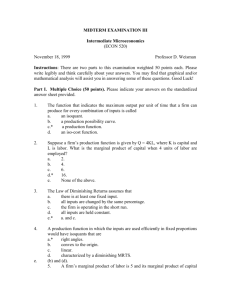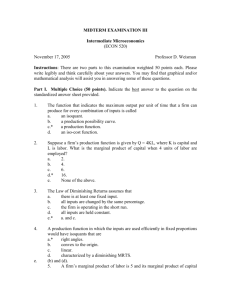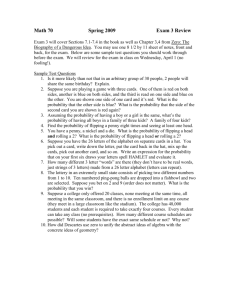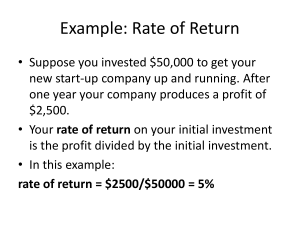MIDTERM EXAMINATION III
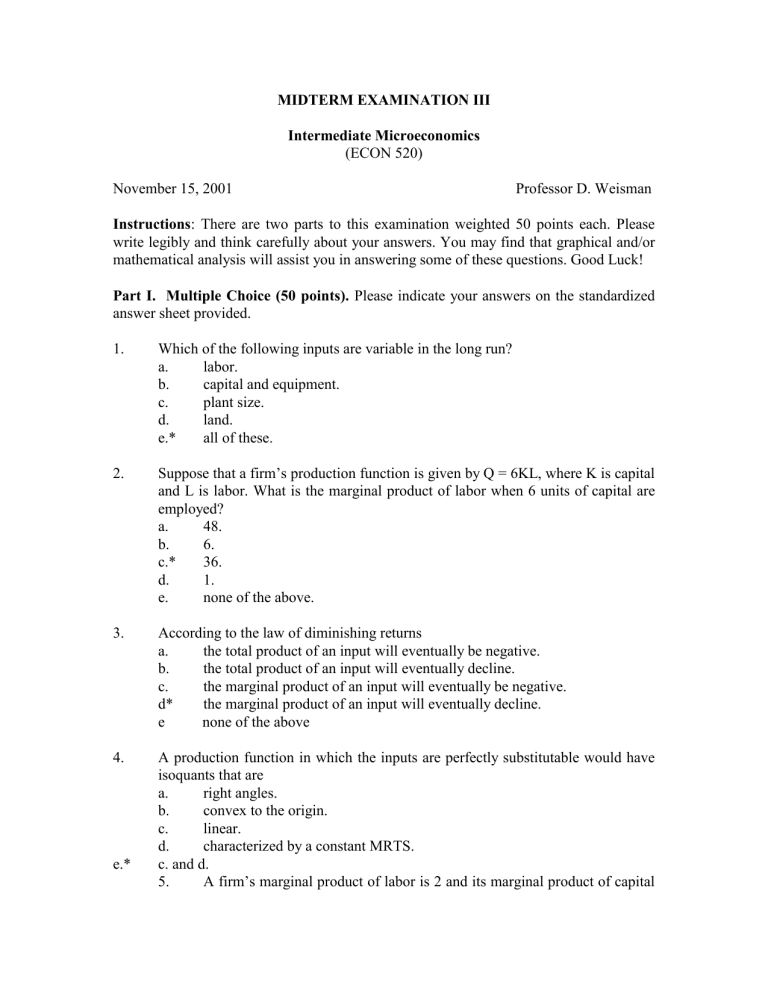
MIDTERM EXAMINATION III
Intermediate Microeconomics
(ECON 520)
November 15, 2001 Professor D. Weisman
Instructions : There are two parts to this examination weighted 50 points each. Please write legibly and think carefully about your answers. You may find that graphical and/or mathematical analysis will assist you in answering some of these questions. Good Luck!
Part I. Multiple Choice (50 points).
Please indicate your answers on the standardized answer sheet provided.
1. Which of the following inputs are variable in the long run? a. b. labor. capital and equipment. c.
plant size. d.
land. e.* all of these.
2. Suppose that a firm’s production function is given by Q = 6KL, where K is capital and L is labor. What is the marginal product of labor when 6 units of capital are employed? a. 48. b. 6. c.* 36. d. 1. e. none of the above.
3. According to the law of diminishing returns a. the total product of an input will eventually be negative. b. c. the total product of an input will eventually decline. the marginal product of an input will eventually be negative. d* the marginal product of an input will eventually decline. e none of the above
4. A production function in which the inputs are perfectly substitutable would have isoquants that are a. right angles. b. c. convex to the origin. linear. d. characterized by a constant MRTS. e.* c. and d.
5.
A firm’s marginal product of labor is 2 and its marginal product of capital
9. is 8. If the firm adds one unit of capital, but does not want its output quantity to change, the firm should a. reduce its use of labor by 8 units. b.* reduce its use of labor by 4 units. c. d. maintain the same level of labor utilization. also increase capital by 1.5 units.
8.
6. In a production process, all inputs are doubled; but output less than doubles. This means that the firm experiences a.* decreasing returns to scale. b. c. constant returns to scale. increasing returns to scale. d.
decreasing costs. e.
c. and d.
7.
A firm is operating in a range of production where there are increasing returns to labor. The firm’s total product when 8 units of labor is employed is 20. The marginal product of the 8th unit of labor is 4. The firm’s total product when 6 units of labor is employed is a. greater than 16 but less than 18. b. c. less than 10. less than 12. d.* greater than 12 but less than 16. e. none of the above. a. b. c. d.
A firm is currently producing its output efficiently using both K and L. Suppose that the price of labor rises and the firm reduces the level of L and increases the level of K with which it operates. Which one of the following production functions is the firm operating with?
Q = 2K + L
Q = 2 min {K, 4L}
Q = 4 min {3K, 3L}
Q = 2K 0.5
L 0.5 e.* a or d.
Which of the following statements is true regarding sunk costs? a. b. c.
Sunk costs have zero opportunity costs.
Sunk costs cannot be recouped once they are incurred.
Sunk costs are irrelevant for making forward-looking decisions. d.* all of the above.
10. Long distance carriers AT&T and MCI are attempting to move into the market for local telephone service in order to exploit a. b. economies of scale. diseconomies of scale.
2
c.* economies of scope. d.
diseconomies of scope. e. diminishing returns to capital.
11.
Assume that a firm’s production process is subject to increasing returns to scale over a broad range of outputs. Long run average costs over this range of output will tend to a. increase. b.* decrease. c. remain constant. d.
fall to a minimum and then rise.
12. A firm that produces using a typical production function finds that at current levels of input utilization it is producing the desired level of output and MP
K
=
MP
L
when r < w. To minimize the cost of producing this level of output, the firm should a.* increase capital utilization and decrease labor utilization. b. maintain current levels of capital and labor utilization. c. increase labor utilization and decrease capital utilization. d. increase both capital and labor utilization. e. none of the above.
13.
The firm’s total cost of producing 10 units of output is 120. At this output level, the firm’s fixed costs are equal to 40. It follows that the firm’s average variable costs are equal to a. b.
12.
6. c.* 8. d. 4. e. none of the above.
14. A firm produces bicycles (B) using wheels (W) and frames (F). Which one of the following production functions describes the production process for bicycles. a. b.*
B = 2W + 1F.
B = min {1/2W, 1F}. c. B = min {2W, 1F}. d. B = W•F. e. none of the above.
15. Suppose that your grade on this examination is described by the production function G = 2.25A
0.5
E 0.5
, where G is your numerical score, A is ability, and E is effort measured in terms of hours studied. Suppose that A = 100. How many hours would you need to study in order to earn a score of 90? a.* 16. b. 12.
3
c. 10. d. 8. e. none of the above.
16.
The government is more likely to approve a merger between two firms if it is known that the production process is characterized by a.* increasing returns to scale. b. constant returns to scale. c. d. e. decreasing returns to scale. b. or c. the law of diminishing returns.
17.
A production function is given by Q = 2K + L, where K is capital and L is labor.
Initially, r = 2 and w = 1. Suppose that w decreases, ceteris paribus . Relative to the initial equilibrium, a.* the total cost of production will fall. b. c. d. the total cost of production will not change more units of capital will be used in production. more units of labor will be used in production.
18.
A firm must make a long-term commitment to operate with a certain production technology. At current input prices, the cost of producing output is the same for each of the 3 production function types. What choice of production technology should the firm choose? a. perfect complements. b.* perfect substitutes. c. typical. d. The firm would be indifferent between the three choices.
19.
There are two inputs to the firm’s production process, K and L. Suppose that the firm has 0 units of L and 10 units of K and is able to produce a positive level of output. What type of production function is the firm operating with? a.* perfect substitutes. b. c. d. e. perfect complements.
“typical.” b. or c. none of the above.
20.
A firm has a production function given by Q = x min{2K, L} Suppose the firm has K = 4 and L = 6 and produces 24 units of output. This implies that x = a. 2 b.* 4 c. 6 d. e.
8 none of the above.
4
Part II. Problems (50 points).
Answer both questions. Each question is worth 25 points.
Show all of your work to receive partial credit. Please write legibly, be precise with your answers, and remember that economy of presentation is a desirable attribute.
1. Let the firm’s production function be given by Q = 4KL. Suppose that r = 4 and w = 2.
Also, MP
K
= 4L and MP
L
= 4K. a) (8) How much K and L is employed in the efficient production of 32 units of output? b) (5) What is the minimum cost of producing 32 units of output? c) (4) How much capital can the firm given up in return for one additional unit of labor in equilibrium if output is maintained at 32 units?
d) (9) Determine whether this production function reflects increasing, decreasing, or constant returns to scale. Are there diminishing, increasing, or constant returns to capital in this production function? Construct a long run average cost curve consistent with the first part of your answer.
2.
Production and Cost Functions.
A.(8) A firm can produce each unit of output with 1/2 unit of capital (K) or 1 unit of labor (L). Write down a production function that reflects these properties.
Suppose that the price of capital (r) = 4 and the firm uses only labor in the production of output. What can you infer about the price of labor (w)?
B.(16) A profit-maximizing firm must make a choice in time period 1 as to the type of technology it will use in time period 2 to produce its output. The firm can make an up-front (sunk) investment of I
A
= 300 in time period 1 to operate with the following production function in time period 2: Q = 2K+L. Alternatively, the firm can make an up-front (sunk) investment of I
B
= 400 in time period 1 to operate with the following production function in time period 2: Q = 8 min {2K, L}.
[There are only 2 time periods in this model.] a) Suppose that r = $12 and w = $2. Derive the cost functions that prevail in time period 2 for each of the two production functions. b) The firm must make a forecast in time period 1 of the quantity of output it expects to sell in time period 2. If the firm makes the investment I
B
= 400 and produces using the production function Q = 8 min{2K, L}, what can you infer about the firm’s forecast level of output? Briefly discuss the economic rationale for your answer?
5
Extra Credit (5):
The firm’s production function is given by Q = 4K 0.25
L
0.25
. Let r = 2 and w = 2. How much K and L will the cost-minimizing firm employ to produce
16 units of output?
6
